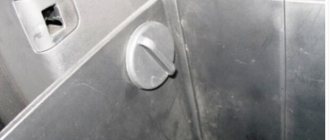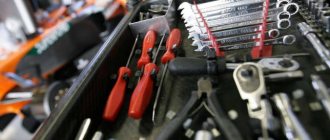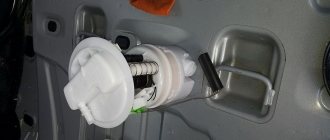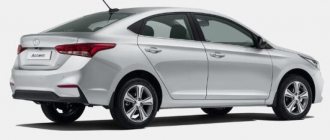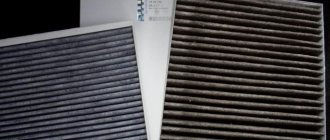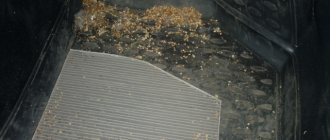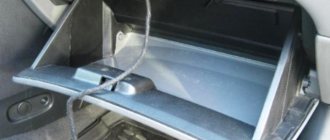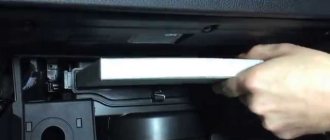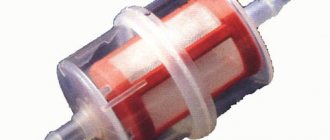Fuel filter replacement interval
According to the regulations, every 30 (diesel) -60 (gasoline) thousand km you need to install a new fuel filter.
However, these intervals are more suitable for the ideal conditions of the states. In Russia, the quality of gasoline is lower than in Europe and other countries, so drivers reduce the interval for changing parts.
Thus, for a diesel engine the interval is 20-25 thousand km, for a gasoline engine 45-50 thousand km.
In addition, the driver’s driving style influences the safety and serviceability of parts.
This is because throughput is rapidly deteriorating. Bandwidth greatly affects the performance of the Kia Sportage 4.
If you delay replacing this part on the Kia Sportage 4, you can cause serious damage. The pump and injectors may fail; replacing these parts costs much more than installing a new filter in time.
Water in the Sportage 4 diesel filter element
The function of a fuel filter in a diesel engine is to separate water from the fuel . This ensures normal engine operation. However, water may accumulate at the bottom of the part. If a lot of liquid has already accumulated there, then when the ignition key is moved to the appropriate position to start the engine, a characteristic lamp on the panel will light up .
The lamp looks like a vessel half filled with liquid.
If it begins to blink, you must immediately, if possible, drain the liquid from the part. Failure to do this will result in water and fuel mixing. Which will ultimately cause a breakdown of the diesel supply system.
Signs of wear
Along with observing the frequency of replacement, we recommend paying attention to the characteristic symptoms that will indicate that the gasoline filter is heavily soiled. The list of such signs includes:
- problems with starting the engine (very often it stalls for no apparent reason);
- sluggish engine response to the gas pedal;
- regular occurrence of blockages in the fuel line;
- accelerated wear of individual elements of the injection system;
- increased fuel consumption.
These signs may indicate several problems, ranging from a clogged fuel filter to dirty injectors, an air filter, or a broken fuel pump.
A more accurate diagnostic method is to measure blood pressure. To do this, you will need to correctly connect the pressure gauge and conduct several experiments. According to the technical documentation for the car, the fuel pressure should be 2.7 kgf/cm2, with the vacuum hose disconnected from the regulator, the indicator should increase to 3.2 kgf/cm2, and the minimum permissible value 5 minutes after turning off the ignition is 1.5 kgf/ cm2. If one or all of the indicators in practice are less than described, look for a problem in the filter or fuel pump.
Choose
Original filter element for the 1.6 G4FJ turbocharged engine - Hyundai/Kia 31112-1W000
31112-1W000
Original article number for diesel 2.0 D4HA - Hyundai/Kia 319-221-K800
319-221-K800
Substitutes:
- PATRON PF-3966-K0R
Factory article number for the G4NA gasoline engine - Hyundai/Kia 311-12C-9000
Analogues:
- SAT ST-311-12C-9000
- KROSS KM-030-3865
Fuel tank absorber filter number – 31184-D7000
31184D7000
Article number of the original filter for 2.4 gasoline (G4KJ) – 311-121-W000
Replacement articles:
- LYNX LF-816M
- ASPACO AP-67081
Troubleshooting
It is advisable to replace the fuel filter according to the regulations - every 60 thousand kilometers. It’s better not to take risks and not use it for more than 65 thousand kilometers. Russian roads, in turn, will “kill” the filter after 35-45 thousand kilometers. Moreover, the quality of gasoline also affects its service life - and it leaves much to be desired.
The most common “symptoms” that it’s time to change the filter:
- fuel consumption has increased significantly;
- the engine does not respond well to pressing the gas pedal;
- the car stalls, the engine does not start well;
- there are constantly blockages in the fuel line;
- injection system elements wear out quickly.
That is why the most rational solution is to replace the filter at least once every two years. Otherwise, elements of the fuel supply system (for example, injectors) will stop working correctly.
The worst outcome is engine failure. If you do not want to overpay for a complete car repair, it is better to comply with the requirements of the regulations. Moreover, consumables are inexpensive - no more than four hundred to five hundred rubles.
To carry out an accurate diagnosis, measure the pressure with a pressure gauge and compare it with the readings in the technical documentation. Significant deviations from the values indicated there are a guarantee that the filter needs to be replaced.
Changing the fuel filter Kia Sportage 4 (gasoline)
To replace this part on a Kia Sportage 4, you first need to remove the negative from the battery, then unscrew the rear seat mounting bolt. After this, you need to disconnect the second row heating connectors and remove the lower part of the sofa.
(link to photo source)
Unscrew the small metal hatch secured with 4 bolts.
(link to photo source)
Next, you need to disconnect the power connector, squeeze the thick hose clamp with pliers, and move it to the side. Remove the thick hose, press the green lock, and pull the thin hose up.
(link to photo source)
After this, you need to unscrew all the bolts around the perimeter of the Kia Sportage 4 filter module plate, then remove it.
(link to photo source)
To remove the module, you need to carefully turn it and turn it to avoid bending the gasoline level sensor.
(link to photo source)
We disassemble the Sportage 4 module
After this, you need to disconnect the plugs from the top of the module. Next, disconnect the hose connectors to be able to remove the upper part and remove the fuel filter.
Please note that initially they need to be carefully pushed forward, this will loosen the fixation. Next, squeeze the clamps on both sides and dismantle.
(link to photo source)
Next, remove the coarse filter from the glass.
(link to photo source)
Remove the pressure regulator, tee. There is no need to disassemble the pump; the wires do not interfere with installing it on a new filter. To do this, you need to squeeze the pump mounting clamps, remove it from the old part, and carefully install it into the new one. Squeeze the clamps and carefully push the pump with the mesh.
(link to photo source)
This completes the replacement of parts; you need to reassemble the system in the reverse order.
Assembling the fuel module for Sportage 4
(link to photo source)
Place the part in the glass, connect the hose connectors. Connecting them is much easier than removing them. However, the clamps will still need to be compressed with a screwdriver. Carefully install the module back into the hatch, turning it so as not to damage the gasoline level sensor.
(link to photo source)
Install a pressure plate on top, secure it with 8 bolts around the perimeter. By pressing the green latch, insert the thin hose into the module, using pliers, as when removing, insert the thick hose back. Connect the power connector to the module, close the hatch with a lid, and fasten it with 4 bolts. Next, replace the rear seat mounting bolt and place the minus on the battery.
Replacement instructions
A few tips before starting work:
- Remember that gasoline is a highly flammable substance, so it is strictly not recommended to replace it near sources of fire or to smoke while working;
- After completing the work, remove all fuel residues that have fallen on the floor or other objects and dispose of them with fuel- and lubricants-impregnated rags in places remote from fire sources;
- Always have a fire extinguisher on hand;
- Try not to get fuel on exposed skin, this is very harmful and contributes to the development of cancer;
- Relieve pressure inside the power system before starting the operation;
- If your car has a coded stereo system, you will need to make sure you know the correct code combination before disconnecting the battery.
Disassembled filter
After reading the attached rules, replacing the filter part in the Kia Sportage can begin. Detailed instructions:
- Find the negative wire and disconnect it.
- After the last trip, at least 3 hours must pass, that is, the work must be performed with a cooled engine. Take your time.
- Remove the air cleaner cover that comes with the air duct.
- Wrap all fitting connections in rags, and collect all spilled fuel with rags or newspapers.
- Fix the nut on the autofilter, and use a wrench to unscrew the bolt (for the union connection), which is located on the fuel line. Separate the line and the autofilter, throw away the washers (they will need to be replaced).
- At the bottom of the filter on the line there is a union nut, which also needs to be unscrewed. Then disconnect the line itself.
- In order to remove the filter itself, you need to loosen the ties and, if necessary, remove the bracket.
- Now take the new part and insert it into the clamp, tighten the bolts by hand. It must be installed strictly according to the instructions so that the directions of the arrows coincide with the direction of the fuel in the power system itself.
In this position, insert the filter - Replace the washers. Connect the line at the bottom and tighten the nut by hand.
- Now you need to tighten the bolt to 30 Nm, hold the filter as expected with a wrench. Tighten the nut to 35 Nm.
- Tighten the ties to 14 Nm.
- Reconnect the negative cables to the battery. Turn on the engine, resume pressure. Check the area for leaks.
Done, the replacement in the Kia Sportage car has been successfully completed.
Selection of components
The original, branded filter will vary depending on the year of the vehicle. For example, if your car was manufactured before the end of the summer of 2012, then you need a fuel under article number 31112-3Q500.
For the cut, purchase the original coarse mesh - you can find it by catalog number 31060-2P000. The main disadvantage of buying factory consumables is the inflated price (from five hundred rubles to two thousand per set).
If your vehicle was manufactured in 2013 or later, then you will need a filter under part number 31112-1R000. The coarse filter can be found under part number 31184-1R000. A good alternative for it would be the nets produced by the NSP and KROSS brands.
Below are good analogues that are in demand among Kia Sportage 3 owners:
Carefully check the packaging before purchasing so as not to stumble upon a fake. Buy components only from trusted sellers.
